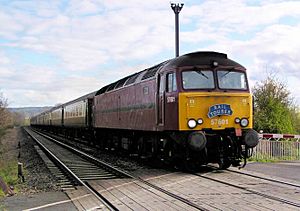British Rail Class 57 facts for kids
Quick facts for kids British Rail Class 57 |
|
 |
|
| Class 57, no. 57012 Freightliner Envoy at Ipswich on 31 January 2004 | |
| Power type | Diesel-electric |
|---|---|
| Builder | Brush Traction or BR Crewe Works; Rebuilt by Brush Traction |
| Build date | Rebuilt: 1997–2004 |
| Total production | 33 |
| Configuration | Co-Co |
| UIC classification | Co'Co' |
| Gauge | 1,435 mm (4 ft 8 1⁄2 in) |
| Length | 19.38 metres (63 ft 7 in) |
| Width | 2.79 metres (9 ft 2 in) |
| Locomotive weight | 57/0 & 57601: 120.6 tonnes (119 long tons; 133 short tons) 57/3 & 57602–57605: 117 tonnes (115 long tons; 129 short tons) |
| Fuel capacity | 57/0: 5,550 L (1,220 imp gal; 1,470 US gal) 57/3 & 57/6: 5,887 L (1,295 imp gal; 1,555 US gal) |
| Prime mover | 57/0: EMD 645-E3 57/3 & 57/6: EMD 645-F3B |
| Engine type | V12 two-stroke diesel |
| Top speed | 57/0: 75 mph (121 km/h) 57/3 & 57/6: 95 mph (153 km/h) |
| Power output | 57/0: 2,500 bhp (1,860 kW) 57/3 & 57/6: 2,750 bhp (2,050 kW) |
| Train heating | 57/0: None 57601: Electric Train Supply index 95 57/3 & 57602–57605: Electric Train Supply index 100 |
| Locomotive brakeforce | 57/0: 80 long tons-force (797 kN) 57/3 & 57/6: 60 long tons-force (598 kN) |
| Train brakes | Air |
| Career | Freightliner Virgin Trains First Great Western Cotswold Rail Direct Rail Services WCRC |
| Number | 57001–57012, 57301–57316 57601–57605 |

The British Rail Class 57 is a special type of diesel locomotive used on railways in the UK. These powerful trains were built by a company called Brush Traction between 1997 and 2004. They are not entirely new trains. Instead, they are older Class 47 locomotives that have been completely rebuilt.
The original Class 47 trains were first used in 1964–1965. For the Class 57, their old bodies were kept, but everything inside was replaced. This included new engines and new wiring. Because of this major overhaul, train fans often call them "bodysnatchers" or "Zombies." It's like they took the body of an old train and gave it a brand new heart and brain!
Contents
What Makes Class 57 Special?
The Class 57 locomotives are unique because they combine old and new parts. They use the strong, proven body of the Class 47. But they have modern, reliable engines and up-to-date electrical systems. This makes them very dependable for different railway jobs.
How They Were Built
The rebuilding process was quite detailed. First, the old Class 47 locomotives were taken apart. Their original engines and wiring were removed. Then, new, more powerful engines were installed. The entire electrical system was also replaced. This gave the trains a new life and improved performance.
Different Types of Class 57 Trains
There are a few different versions of the Class 57, each designed for specific tasks:
- Class 57/0: These were mainly used for pulling freight trains. They have a top speed of about 75 miles per hour.
- Class 57/3: These trains were built for passenger services. They can go faster, up to 95 miles per hour. They also have special equipment to provide power for passenger coaches.
- Class 57/6: Similar to the 57/3, these were also used for passenger trains. They have similar speed and power capabilities.
Who Uses Class 57 Locomotives?
Over the years, many different railway companies have used Class 57 trains. Some of the well-known operators include:
- Freightliner (for moving goods)
- Virgin Trains (for passenger services)
- First Great Western
- Direct Rail Services
- West Coast Railway Company (often for special charter trains)
These trains are very versatile. This means they can be used for many different jobs. They pull heavy freight trains and also carry passengers on important routes. Their reliability makes them a valuable part of the UK railway network.
Images for kids
-
Direct Rail Services 57304 at Crewe
-
Great Western Railway 57604 at the National Railway Museum
-
West Coast Railways 57316 at Derby
-
Arriva Trains Wales liveried 57315 hauling the Premier Service at Newport station in June 2009
-
Freightliner 57007 at Northampton station in July 2006
-
Network Rail 57305, 57312 & 57310 at Eastleigh station in February 2014
-
Thunderbirds International Rescue crest and Gordon Tracy nameplate on 57304 in April 2006
-
Virgin Trains 57307 Lady Penelope at Castleton East Junction in July 2008











